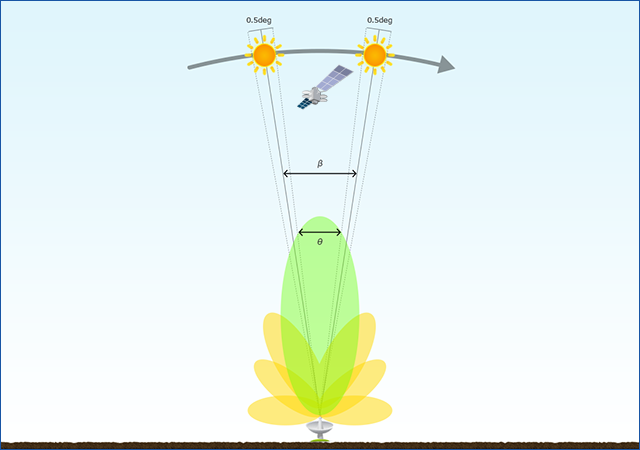SKY Perfect JSAT defines the duration of the sun interference as the length of time it takes for the sun to cross the receive antenna’s half power beam width.
β = 0.5 + θ [degrees]
β: Angle when the sun crosses the half power beam width of the receive antenna
θ: Angle of the half power beam width of the receive antenna
0.5: Apparent diameter of the sun as seen from the earth is about 0.5 degrees.
Since the sun rotates one degree in 4 minutes, the longest length of time the sun moves across the receive antenna's half power beam width (i.e. duration of sun interference), is calculated as follows:
4 x β [minutes]
Moreover, since the sun's declination changes 0.4 degree a day, the maximum number of days the sun stays within the receive antenna's half power beam width (i.e. period of sun interference) is:
β / 0.4 [days]
The value of the receive antenna's half power beam width for a typical parabolic antenna is predicted as follows:
θ = 70 x λ / D [degrees]
λ: Wave length of the receive frequency [meters]
D: Diameter of the receive antenna [meters]
Therefore, the larger the diameter of the receive antenna is, the shorter the time and fewer days the sun interference will last. Additionally, since the antenna gain increases in proportion to diameter of the antenna, the effect of sun interference increases for earth stations with larger antennas.
If your antenna diameter is larger than 2.4 m for Ku-band or 7.6 m for C-band, please refer to the time for 2.4 m or 7.6 m respectively. The larger the antenna diameter is, the shorter the duration time becomes ensuing other factors to be dominant contributors. Since impact of the mentioned “other factors” is negligibly minimum, duration time will converge to the values calculated for 2.4m and 7.6m for Ku band and C band respectively.
However, it should also be taken into account that quality of communication links and effects of sun interference are determined not only by the diameter of the receive antenna but also by other factors such as link margin of each earth station, noise temperature of receivers, types of communication systems used, etc.

